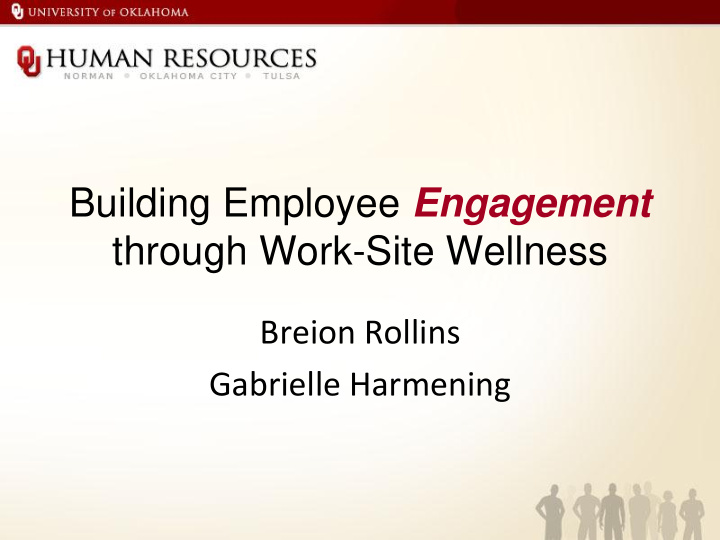



Building Employee Engagement through Work-Site Wellness Breion Rollins Gabrielle Harmening
Wellness is Good Business • Studies show healthier employees tend to miss less work, recover quickly from illness, and are more satisfied with their jobs, leading to greater productivity and reduced turnover. • Wellness Council of America, research suggests that corporate wellness programs can bring anywhere from a two-to-one to six-to-one return on investment when wellness is integrated into an organization's business strategy. 2
Why Wellness Doesn't Work? "If you build it, they will come" The Field of Dreams • Culture • Change is Hard • Business Strategy • Lack of Communication 3
" We know that if individuals are to make a sustainable behavior change, they must be in an environment that supports that change. If someone changes a behavior and then returns to the same unhealthy environment that caused or aggravated the behavior, the chances are pretty good that they will return to their original behavior " Source: Dee Edington, Director of Health Management Research Center at the University of Michigan 4
Engagement is a Business Strategy Leadership sets the tone and vision Wellness objectives align with organizational strategy Lead by example; visible support and commitment 5
Create the Culture: Align the Workplace with Vision Culture is a set of shared attitudes, values, goals, and practices that characterizes a company or corporation. Culture is reflected in: communications management priorities benefits design policies/processes physical environment 6
Create the Culture: Align the Workplace with Vision Environment – Tobacco-free environments – Use of physical space – Workplace design Communications – Inclusive & transparent – Keep it simple 7
Engagement Employee engagement is the single most important factor in improving health outcomes and lowering costs. Engaged employees work with passion and feel a profound connection to their company; attentive, focused and committed. Lack of engagement costs American businesses $370 billion a year (Gallup) 8
How They Did It: Healthy Sooners Case Study – Who We Are http://healthysooners.ouhsc.edu • Healthy Sooners is the faculty and staff wellness program at The University of Oklahoma, a division of Human Resources. • We are a comprehensive Health Promotion program, supporting over 10,000 employees at three campus locations. – What We Do • Developed a process which focuses on major outcomes – Branding, Promotion, Education and Vendor Collaboration – Aggregate Risk Factor Detection – Employee Assistance Resources
Engagement in Action • Wellness Offerings • Wellness Champions • Communications • Wellness Committee • Physical Environment • Group Activities
Wellness Offerings • Committee and Participants Drive Programs – Weight Watchers at Work – Aging Parents Care Giving Group – Annual Fun Run – Biometric Screenings
Communication Example…
Physical Environment
Long-term Behavior Change Support continuous behavior – Reward the behaviors, actions, and results you want to achieve – Address issues with the greatest return Intrinsic motivations = sustained change – Autonomy and self- efficacy – Mastery – Purpose Barriers – Keep it fair – Remove negative perceptions – Readiness to Change 14
Questions
References Survey of Health Care Consumers: Key Findings, Strategic Implications, March 2009 What’s the Hard Return on Employee Wellness Programs, Harvard Business Review 2010 National Business Group On Health, Large Employers’ 2011 Health Plan Design Changes, August 2010 WELCOA: Gold Standard for Worksite Wellness and ROI 2009 Edelman et. al., Successful Wellness, American Journal of Health Promotion, 2006 Making the Case for Wellness as a Business Strategy, Buck Consultants 2009 C. Everett Koop Awards Prevention Makes Common Cents published in Sept. 2003 by the Dept. of Health and Human Services Zero Trends: Health as a Serious Economic Strategy, Dr. Dee Edington, University of Michigan 2009 Watson Wyatt Worldwide: Evaluation of Worksite Wellness programs and their effectiveness, 2009 Simon, T. (2007) Wellness Programs Incentives: What’s allowed, what’s not. Mercer. London School of Economics Department of Management. When performance-related pay backfires, 2009 Nudge: Improving Decisions About Health, Wealth, and Happiness, Richard Thaler, Cass R. Sunstien, 2008 Sway: The Irresistible Pull of Irrational Behavior, Rom and Ori Brafman, 2009 Glasgow and Loeppke Creating a Culture of Worksite Health and Wellness, LRP Productions, 2009 Donnelly, Julie “Massaging employee health: Financial incentives change behaviors, Boston Business Journal (2009) Burd, Steven A “How Safeway is Cutting Health - Care Costs.” Wall Street Journal, 2009 & 2010 U.S. Partnership for Prevention A National Profile on Use, Disparities, and health Benefits. Partnership for Prevention, 2007 & 2010. U.S. Workplace Wellness Alliance: The Burden of Chronic Disease on Business, 2009
Recommend
More recommend